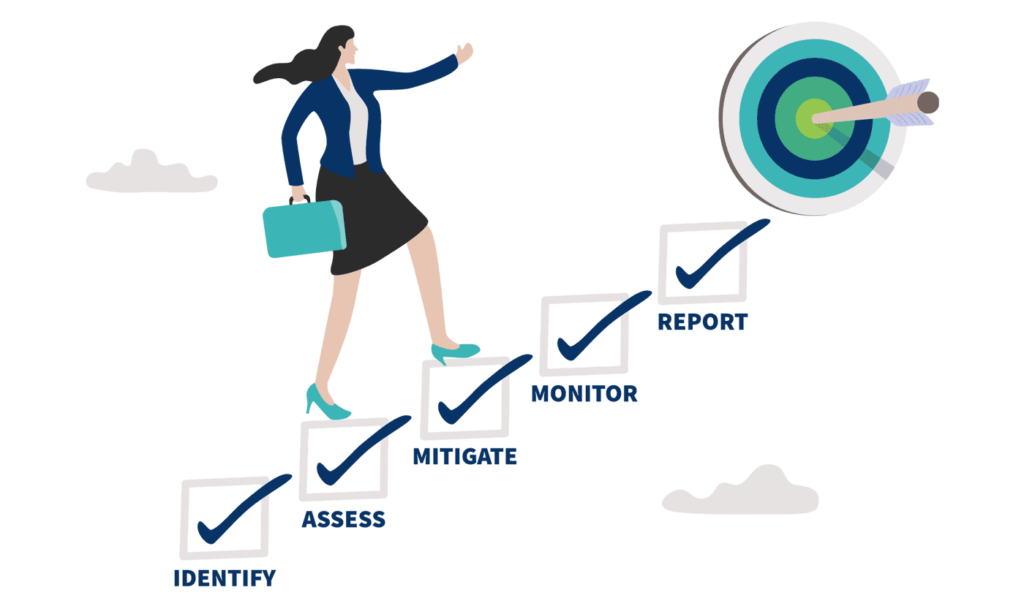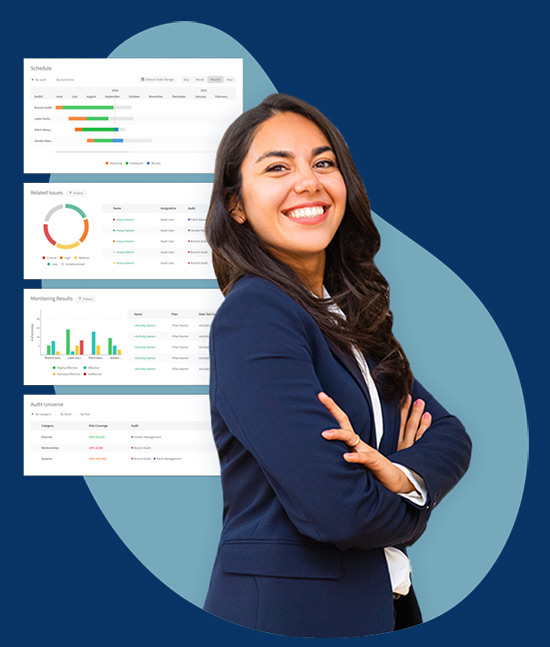ERM vs GRC Software
If you are looking for a governance, risk, and compliance solution, you might be frustrated by the limitations and challenges of GRC software. GRC software can fail to provide a clear vision for your risk management and governance program, struggle to communicate the value and benefits of your program to your stakeholders, and rely on manual, outdated processes.
That’s why we recommend Enterprise Risk Management as the better approach. Unlike GRC software, we take ERM seriously. LogicManager’s flexible and intuitive ERM software includes a comprehensive matrix of solutions that accelerate and amplify your risk management efforts to provide prioritization, business insights, and engagement with your stakeholders. Regardless of your role or responsibilities or how you structure your risk management and governance program, we have you covered.
Request a demo to discover why LogicManager’s ERM software is the best choice for your governance, risk, and compliance needs.
Typical GRC Platform
Focused on past performance and the present state
Siloed Process- Each department is working independently producing redundant insights with twice the effort
No centralized view of risk for board reporting and decision making
Duplication of efforts on control development and testing
Reactive approach to risk events
No baseline to understand current risk maturity
LogicManager (ERM)
Forward facing risk-based approach
Principles based focus with more emphasis on incorporating risk assessments into strategic discussions
Provides a large degree of protection from lawsuits and regulatory fines
Integrated approach between business areas and processes
More actionable insights
Risk baseline established to plan for the future
Take a Risk-Based Approach to GRC
LogicManager ERM Software is not just another GRC tool, but a comprehensive and holistic approach that connects the dots between your GRC functions and your enterprise risk profile. ERM works because risk is the underlying link between GRC functions. If we recognize that each silo’s function – regardless of whether its labeled risk, compliance, or governance – is actually working to mitigate a subset of the organization’s enterprise risk, we suddenly begin to see commonalities and realize efficiency that results in bottom-line value. LogicManager helps you to create a risk-based culture that fosters collaboration, transparency, and accountability.

- Identify the most critical risks and opportunities across your organization, using our centralized risk library and readiness assessments.
- Assess the likelihood and impact of each risk and opportunity, using our customizable risk assessments and templates.
- Mitigate the risks and leverage the opportunities, using our best practice controls and policy automation.
- Monitor the performance and effectiveness of your risk management and compliance program, using our testing, KRI/KPI, and policy portal features.
- Report the results and insights of your risk management and compliance program, using our audit trail, reports, and dashboards.
ERM Solutions to Bridge Your Risk Journey Across Silos
Your risks are all interconnected. Our governance area and point solution packages are built on a taxonomy platform, so they can be easily integrated into any department and support you throughout the entirety of your organization’s risk journey.
The LogicManager Difference
We take the risk so you do not have to. We evaluate each solution’s effectiveness to ensure your success and hold ourselves accountable with an unconditional money-back guarantee. We are dedicated to evolving with you as your needs expand.
Our fixed pricing model offers unlimited licensing and everything you need to succeed in risk management. With no surprise fees, our no-code technology allows for easy configuration and we provide additional support from our advisory team at no extra cost.
We’re not just a software provider, but your trusted partner in enterprise risk management. From one-on-one training sessions to answering technical and best-practice questions, our dedicated advisory analysts are with you every step of the way.
Frequently Asked Questions About GRC Software
GRC software is a technology solution that is meant to help organizations manage their governance, risk, and compliance processes. It typically integrates data and workflows from different sources and functions, such as internal audit, legal, IT, security, and regulatory affairs.
However, enterprise risk management software takes a more holistic and strategic approach to risk management, which makes it superior to GRC software solutions. ERM considers all types of risks that could affect an organization’s objectives, not just those related to governance and compliance. ERM also allows managers to shape the organization’s risk profile and appetite, rather than just following rules and regulations. ERM helps organizations create value and seize opportunities, while GRC can sometimes be seen as a cost center and a constraint. Therefore, depending on the organization’s needs and goals, ERM may be a more suitable and effective framework than GRC for managing risks and enhancing performance
To learn more about GRC vs. ERM, check out our guide.
GRC and ERM are both frameworks for managing risks and achieving organizational goals. However, they differ in their scope, approach, and focus. GRC is more narrow and prescriptive, focusing on specific governance, risk, and compliance functions and requirements. ERM is more holistic and principles-based, considering all types of risks and their impact on the organization’s objectives. ERM also allows more flexibility and innovation in shaping the organization’s risk profile and appetite, while GRC can be more rigid and rule-bound.
GRC is a structured way to manage risks and meet industry and government regulations. However, implementing GRC as a framework also has some downsides, such as:
- It can be challenging to integrate risk management and compliance processes across different departments and business units, which may have their own data, technology, and objectives.
- It can be costly and time-consuming to develop a comprehensive and flexible GRC framework that covers all the relevant regulations and policies, and to keep it updated as the business environment changes.
- It can be difficult to measure the effectiveness and value of GRC activities, and to communicate them to senior management and stakeholders.
- It can create a culture of over-compliance and risk aversion, which may stifle innovation and creativity.
Relying on GRC software is insufficient to handle today’s ever-changing risks and regulations. LogicManager recommends taking a risk-based approach that removes friction and fragmentation across the entire enterprise while placing risk at the heart of all business decisions.

Request a Demo of LogicManager ERM SoftwareDon’t settle for a siloed and fragmented GRC software solution
Speak with one of our risk specialists today and discover how you can empower your organization to uphold their reputation, anticipate what’s ahead, and improve business performance through strong governance.


